|
Thursday, Oct. 2
1 p.m.
Research Techniques Seminar - West Wing, WH-10NW
Speaker: Nicoleta Dinu, LAL, Orsay
Title: Electro-Optical Characterization of SiPM Detectors
2:30 p.m.
Theoretical Physics Seminar - Curia II
Speaker: Jnan Maharana, Institute of Physics, Bhubaneswar
Title: Axion-Dilaton String Cosmology
3:30 p.m.
DIRECTOR'S COFFEE BREAK - 2nd Flr X-Over
THERE WILL BE NO ACCELERATOR PHYSICS AND TECHNOLOGY SEMINAR TODAY
THERE WILL BE NO PHYSICS AND DETECTOR SEMINAR THIS WEEK
Friday, Oct. 3
3:30 p.m.
DIRECTOR'S COFFEE BREAK - 2nd Flr X-Over
4 p.m.
Joint Experimental-Theoretical Physics Seminar - One West
Speaker: Robert Bernstein, Fermilab
Title: A New Search for Charged Lepton Flavor Violation: Muon-Electron Conversion at Fermilab
Saturday, Oct. 4
8 p.m.
Fermilab Arts Series - Ramsey Auditorium
Title: Aquila Theatre performing Shakespeare's "Comedy of Errors"
Tickets: $30/$15
Click here for NALCAL,
a weekly calendar with links to additional information. |
|
Thursday, Oct. 2
- Southwestern Chicken Tortilla
- Philly Style Cheese Steak
- *Garlic Herb Roasted Pork
- Smart cuisine: Southwestern Grilled Chicken
- *Southwestern Turkey Wrap
- Assorted Slice Pizza
- *Marinated Grilled Chicken Caesar Salads
*Carb restricted alternative
Wilson Hall Cafe menu |
Thursday, Oct. 2
Dinner
- Frisée & apple salad w/dried cherries and walnuts
- Paella
- Pineapple flan
Wednedsay, Oct. 8
Lunch
- Northern Italian lasagna
- Caesar salad
- Cassata
Chez Leon menu
Call x4598 to make your reservation. |
|
|
Homing in on the dark elements
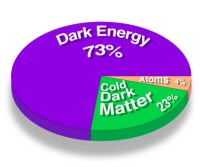 |
| Visible matter makes up only about 4 percent our universe. Scientists believe that dark matter and dark energy make up the rest. Source: Robert Kirschner; NASA/WMAP Science Team |
Tapping into dark discoveries could soon revolutionize our understanding of
what holds our universe together - out to the farthest reaches of space and
down to the smallest particle.
The next big discoveries will spring from the search for dark energy and dark matter, said researchers at a lecture, "The Dark Side of the Universe," at the Smithsonian Museum of Natural History in Washington, D.C, on Wednesday, Sept. 24.
The Smithsonian looks for speakers on topics at the forefront of science.
Dark matter and dark energy certainly fit that bill, said Melody Curtis, senior program coordinator for the Smithsonian Associates.
University of Chicago cosmologist Michael Turner moderated the lecture by Fermilab particle physicist Joe Lykken and University of Chicago astrophysicist Rocky Kolb. The speakers said to the crowd of almost 400 that they have high hopes for the study of dark matter and dark energy, the poorly understood elements scientists say make up 96 percent of the universe.
"I think every scientist has this bad moment when they think, 'Gee, all
the scientists who came before me, they had it easy,'" said Lykken, a particle theorist, during the lecture. "They had all these great things just lying around to discover. But we have found that the whole universe is up for grabs."
Lykken and Kolb jousted playfully throughout the lecture about which discipline would grasp a new understanding first: particle physics or astronomy.
Lykken hypothesized that within three years particle physicists would discover dark matter using the newly minted Large Hadron Collider.
"We will first discover it with astronomy - in two and a half years," Kolb shot back.
The most exciting outcome may lay with dark energy, not dark matter, the researchers said, particularly if dark energy, the force that may be propelling the universe to expand at faster and faster rates, were proved not to exist.
"It could be that dark energy is the ether of the 21st Century," Kolb said. "We think it's there, but perhaps there's something even odder going on, even more surprising."
-- Kathryn Grim
|
Encouraging words
Editor's note: US CMS Collaboration Board Chair Nick
Hadley sent this letter to US CMS graduate students and post-docs to raise
their sprits after learning that the LHC will not turn back on until spring of 2009.
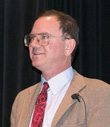 |
| Nick Hadley |
Dear US CMS graduate students and post-docs,
I realize that the delay in LHC start-up due to the incident in
sector 3-4 is disappointing. I'd like to emphasize that these
kinds of problems are typical in machine start-ups. Based on
my experience working on experiments at SLAC, Brookhaven and Fermilab, new machines don't turn on smoothly.
Nevertheless, the accelerators did turn on and the experiments started and the students graduated and the post-docs got jobs. My own thesis experiment was delayed by a year when our superconducting magnet was destroyed by a short. The accelerator's luminosity was about 100 times less than design. At the time, the delay seemed devastating, but I did finish, and the delay didn't affect my next job. (It's worth noting that my two office mates, who were also delayed in graduating, have just finished terms as chairs of the physics departments at Harvard and Berkeley respectively.)
The Accelerator group at CERN is excellent. The detailed machine diagnostics
and simulations that were ready on day one show that the group has meticulously
prepared for LHC start-up. They have overcome many problems over the years. You
can expect that they will fix this one, as well and continue their tremendous
track record in accelerator operations.
We can use the time between now and early spring to get ready for first
data, and thus first publications need not be delayed by as much time as
the beam.
Sincerely,
Nick Hadley, Chair US CMS Collaboration Board
|
Grid Fest occurs tomorrow
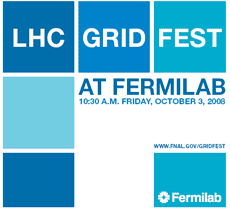
Grid Fest will take place Oct. 3
Celebrate the launch of the LHC Computing Grid at Fermilab's Remote Operations Center on Friday, Oct. 3, at 10:30 a.m. Experts will highlight the successes and challenges of the grid and its applications for other sciences.
More information
|
Do we live in a giant cosmic bubble?
From USA Today, Sept. 30, 2008
If the notion of dark energy sounds improbable, get ready for an even more outlandish suggestion.
Earth may be trapped in an abnormal bubble of space-time that is particularly void of matter. Scientists say this condition could account for the apparent acceleration of the universe's expansion, for which dark energy currently is the leading explanation.
Dark energy is the name given to the hypothetical force that could be drawing all the stuff in the universe outward at an ever-increasing rate. Current thinking is that 74% of the universe could be made up of this exotic dark energy, with another 21% being dark matter, and normal matter comprising the remaining 5%.
Until now, there has been no good way to choose between dark energy or the void explanation, but a new study outlines a potential test of the bubble scenario.
If we were in an unusually sparse area of the universe, then things could look farther away than they really are and there would be no need to rely on dark energy as an explanation for certain astronomical observations.
"If we lived in a very large under-density, then the space-time itself wouldn't be accelerating," said researcher Timothy Clifton of Oxford University in England. "It would just be that the observations, if interpreted in the usual way, would look like they were."
Scientists first detected the acceleration by noting that distant supernovae seemed to be moving away from us faster than they should be. One type of supernova (called Type Ia) is a useful distance indicator, because the explosions always have the same intrinsic brightness. Since light gets dimmer the farther it travels, that means that when the supernovae appear faint to us, they are far away, and when they appear bright, they are closer in.
But if we happened to be in a portion of the universe with less matter in it than normal, then the space-time around us would be different than it is outside, because matter warps space-time. Light travelling from supernovae outside our bubble would appear dimmer, because the light would diverge more than we would expect once it got inside our void.
Read more
|
|
|
Can beauty guide us to the super world?

The figure shows the new limits on the gluino vs.
sbottom masses in comparison with previous searches.
Despite its extraordinary success in describing the world as we see it,
the Standard Model does not answer some of the most important questions about
the universe. To address these questions, scientists have come up with extensions to the
Standard Model. One of the most attractive of these theories, Supersymmetry,
does this by adding a new partner particle, called superpartner, for
each Standard Model particle. Supersymmetry could explain one of the
great mysteries of cosmology: that a predicted SUSY particle, the neutralino, may be the constituent of the dark matter in the universe.
Physicists at CDF have been trying to confirm the existence of Supersymmetry
by looking for it in as many corners of their data as possible. Since
neutralinos don't interact with matter, thus escaping detection, the existence
of Supersymmetry has to be confirmed or refuted by studying combinations of
observable particles not explained by Standard Model processes.
In this analysis, CDF physicists looked for the production of four
collimated sprays of energy from beauty quarks and a large imbalance
of energy from two neutralinos.
This topology is rare in the Standard Model, but could easily be produced at
the Tevatron through gluinos, the super partner of the gluon. These
superparticles would then decay into the supersymmetric beauty quark (sbottom).
To find these exotic events, scientists have to thoroughly understand the backgrounds - the Standard Model physics processes that might mimic the signal that scientists are looking for. This can be a very difficult job for physicists at hadron colliders looking for a rare process. In this analysis, the authors developed an innovative technique to understand these background contributions from known physics processes by using CDF data directly rather than the more common technique of utilizing Monte Carlo simulation.
After determining and subtracting these Standard Model backgrounds, the authors observed no evidence of sbottoms produced via gluino decays in the CDF data. This agreement between data and predicted known backgrounds allows the scientists to set the world's best limit in this particular channel, squeezing Supersymmetry even further into a corner.
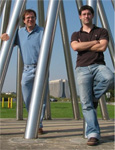 |
The authors of this CDF analysis, standing next to one of Fermilab's sculptures: Oscar Gonzalez and Miguel Vidal, both from CIEMAT (Spain). |
|
Join Fermilab's Volunteer Prairie Seed Harvest Saturday
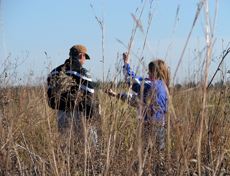
Two volunteers collect seed from prairie within the Main Ring at this year's second Prairie Seed Harvest on Nov. 3, 2007.
On Oct. 4, from 10 a.m. to 2 p.m. you take your green-thumb skills to a new level to help restore Fermilab's prairie by collecting native seeds. Some of the seeds replenish land at the laboratory while others help build prairies at area schools. Enter at Pine Street and follow signs to the Harvest. Wear field clothes and gloves and bring hand clippers and paper bags. A picnic lunch will be provided. If bringing a group, contact Roads and Grounds' Jeanette Olah at olah@fnal.gov. For more information, contact the Office of Communication at (630) 840-3351. More information
|
Power Outage Monday
A one-week shutdown of the Accelerator Complex will take place Monday, Oct. 6,
through Friday, Oct. 10, for maintenance. The shutdown is necessary to switch
a 345,000 volt power line that feeds the master substation. To replace the power
line, the substation will be shut off on Monday, Oct. 6, and Friday, Oct. 10 to
Wilson Hall, the Lederman Science Center and the Accelerator Complex from 7-7:25
a.m. This will not affect power to the Village.
The replacement is weather related, so bad weather may extend the shutdown and
move the second power outage.
While this replacement is being made, AD will take the week-long opportunity to do preventative maintenance and any necessary repairs.
Turn off computers on Friday, Oct. 3 and Thursday, Oct. 9, before leaving for the night. Check Fermilab Today for additional news.
|
|
Have a safe day!
Photos wanted for labwide party
At the labwide party on Oct. 17, a slideshow on the video screen in the atrium will show images of people at Fermilab. We are looking for additional photos of you and your colleagues here at work--in your office or work area, at a department picnic, during lunch in the cafeteria, etc. Please e-mail your jpeg files to lwp08@fnal.gov by Friday, Oct. 10. Depending on the number of photos we will receive, we might not be able to include every photo in the slideshow.
Volunteers needed: Show your (artistic) muscles
The Fermilab Arts & Lecture Series needs some help for a couple of hours on
Saturday, Oct. 4, at 10 a.m. to carry equipment and set up the stage for the
Aquila Theatre's production of Shakespeare's "Comedy of Errors" in Ramsey
Auditorium. Volunteers will receive two free tickets for Saturday evening's
performance. We also need someone to help with costume changes backstage
during the performance, which begins at 8 p.m. E-mail mackay@fnal.gov as soon as possible if you would like to volunteer. For regular tickets, call 630-840-2787. More information
Wilson Hall relamping underway
Replacement of all flourescent light bulbs in Wilson Hall is underway. Workers will replace bulbs one floor at a time, beginning on the 15th floor and working downward.
"Comedy of Errors," Oct. 4
The New York-based Aquila Theatre Company will perform Shakespeare's "Comedy
of Errors" in Ramsey Auditorium on Saturday, Oct. 4, at 8 p.m. Tickets are
$30 adults/$15 ages 18 and under. Bring a new patron and receive tickets at
50 percent off. Dr. David Bevington, Shakespeare expert at the University of
Chicago, will offer a free preperformance talk at 7 p.m. in One West. More
information.
Stay warm, save money
October is Energy Awareness Month. The U.S. Department of Energy has
launched its Stay Warm,
Save Money Web site
and educational outreach campaign to help consumers be more energy efficient
and save on energy costs. The information focuses on proactive ways
to implement simple, cost-effective, energy-saving solutions for
both homes and businesses.
International Folk Dancing Thursday
International Folk Dancing will take place in the Kuhn Village Barn on Thursday, Oct. 2. Dancing begins at 7:30 p.m. with teaching and children's dances earlier in the evening and request dancing later. For more information, call (630) 584-0825 or (630) 840-8194 or e-mail folkdance@fnal.gov.
Additional Activities
|
|